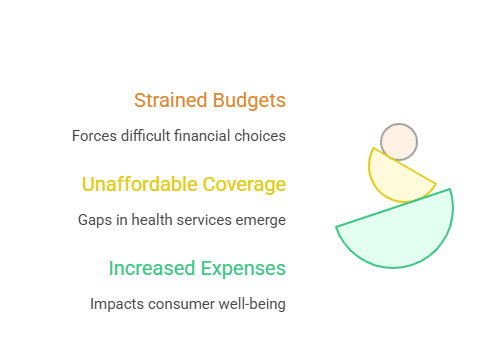On-Demand Outsourcing BPO Services for Healthcare Providers With 24/7 Coverage!
Save up to 70% on staffing costs!
Browse Specialty Staffing ServicesWhen Insurance Premiums Rise Faster Than Paychecks?

Healthcare professionals across the country are bracing for sticker shock. One family practitioner captured the mounting frustration: “I am at 22% of my income for health insurance premiums for my family of three and am not looking forward to the increase in premiums yet again.”
The numbers are staggering. If Congress lets ACA subsidies expire, premiums across marketplace plans will jump an average of 114%. Even employer-based plans aren’t safe, with projected increases of 6.5% – the biggest spike in 15 years.
Forum discussions reveal a healthcare system pushing professionals and patients to the breaking point. The conversation raises a critical question: “how much of your paycheck should health care be allowed to take before we call it theft?”
Almost $20,000 Per Year Before We Even Step Foot Into a Doctor’s Office”
Healthcare professionals are sharing the brutal math of staying insured. One practitioner detailed their family costs: “Almost $20,000 per year for premiums before we even step foot into a doctor’s office is absurd. The system is broken!”
The discussion thread reveals families already allocating rent-sized portions of their income to healthcare coverage. As one respondent noted: “22% is crushing — and you’re not alone. Way too many families are in the same boat, paying rent-sized bills just to keep insurance.”
For healthcare practices, these premium increases create a cascade of operational challenges. Staff members struggle with their own insurance costs while practices face pressure to increase compensation to offset rising healthcare expenses. One office manager observed: “My premium for a single, HDP went up 50%. While it’s still a relatively low dollar amount, the percentage increase was high. I can’t imagine how those with family plans are coping.”
The reality is stark: when healthcare workers themselves are dedicating a fifth or more of their income to insurance premiums, something fundamental has broken in the system.
“When People Are Handing Over a Fifth of Their Income Before They Even See a Doctor”
The administrative burden on healthcare practices intensifies as insurance costs spiral. Practices must navigate complex subsidy eligibility determinations, marketplace options, and increasingly frustrated employees seeking benefits guidance.
Healthcare professionals emphasize the real-world impact: “When people are handing over a fifth (or more) of their income before they even see a doctor, that’s not a safety net — that’s a weight dragging families under.”
The enhanced subsidies temporarily put in place during COVID are set to expire, and healthcare professionals report significant confusion about what comes next. One practitioner explained: “The enhanced subsidies, which were temporarily put into place during Covid, are set to expire and those making above 400% of fpl will see the massive increases.”
For practice administrators, this translates to increased time spent on benefits administration, employee counseling about insurance options, and managing the operational impact of staff financial stress. The administrative overhead compounds as practices work to help employees understand eligibility, subsidies, and coverage options while managing their own operational costs.
“It Went Up Big Each of the Last 3 Years for Employer Plans”
Employer-sponsored plans aren’t providing the stability they once did. Healthcare professionals report: “it went up big each of the last 3 years for employer plans at least. it’s already a racket.”
The consistent year-over-year increases force difficult decisions. Some healthcare workers are making dramatic changes: “i am looking at doing a super high deductible hsa plan to go with direct primary care to bypass insurance for the majority of things.”
When healthcare professionals themselves start “bypassing insurance for the majority of things,” the system has fundamentally failed its purpose. As one practitioner noted: “when people start talking about bypassing insurance entirely, that’s not ‘market choice,’ that’s a survival move.”
Practice operations feel the ripple effects. High deductible plans mean increased patient billing complexity, more payment plan requests, and staff time spent explaining costs and payment options. Front desk personnel field more questions about pricing, while billing departments manage increased payment plan administration.
The Real Cost: “My Son Got the Letter That Medicaid Will No Longer Cover His Medications”
Beyond premiums, healthcare professionals are witnessing coverage gaps with devastating consequences. One parent shared: “My son this week got the letter that medicaid will no longer cover his medications which will as of yesterday go up by about $1800/mo.”
Another healthcare worker on Medicare reported: “I’m on Medicare and I have traditional Medicare and a supplement. No prescription coverage. I’m paying almost $400 a month which is 20% of my total income. And I cannot get things like RSV vaccine or shingles vaccine because they are several hundred dollars each.”
For healthcare practices, these coverage gaps create ethical dilemmas and operational challenges. Providers must balance medical necessity with patient financial reality, spending time researching alternatives, applying for patient assistance programs, and navigating prior authorization denials.
The administrative burden of fighting coverage denials, appealing medication rejections, and managing patient assistance programs consumes significant staff time that could be directed toward patient care.
“Medicare Advantage Plans Are Being Pulled From 60 or More Counties”
Healthcare professionals are tracking another concerning trend: “Some Medicare advantage plans are being pulled from 60 or more counties come the 2026 year.”
This creates administrative chaos for practices. Patient panels shift as coverage changes, existing authorizations may become invalid, and practices must verify new insurance information, update systems, and help patients navigate unexpected coverage transitions.
The operational impact is substantial. Staff must contact affected patients, verify new coverage, resubmit authorization requests, and manage the billing complexities of mid-year insurance changes. For smaller practices without dedicated insurance verification staff, this represents a significant administrative burden.
How Healthcare Practices Are Managing Rising Insurance Administrative Costs
While insurance premiums continue their upward trajectory, forward-thinking healthcare practices are finding operational cost relief through strategic administrative staffing solutions. The key is addressing the expanding administrative burden without proportionally expanding administrative costs.
Virtual Insurance Verification Specialists: Cost Control During Cost Chaos
Insurance eligibility verification and benefits confirmation represent one of the most time-consuming administrative tasks in healthcare practices. As coverage becomes more complex and changes more frequent, the administrative burden intensifies.
Virtual insurance verification specialists provide a cost-effective solution. These professionals handle benefits checks, deductible confirmation, eligibility verification, and coverage change documentation at a fraction of traditional staffing costs.
Healthcare practices report significant advantages with specialized virtual insurance teams:
Specialized Healthcare Knowledge: Virtual insurance specialists from India and Pakistan often have healthcare educational backgrounds including Medical Doctors, Nurses, and PharmDs, while companies also source talent from the Philippines and other countries with strong healthcare administration capabilities. Many hold U.S. pharmacy licenses and MHA degrees, ensuring clinical understanding combined with insurance operations expertise.
Cost Structure That Actually Makes Sense: Virtual insurance verification specialists cost under $2,000 monthly compared to local administrative staff at $4,500 base salary plus payroll costs and benefits totaling up to $6,000 monthly – a savings of $4,000+ per position.
Handling Volume Without Proportional Cost Increases: As patient insurance complexity increases with subsidy expirations and coverage changes, virtual teams can scale to handle increased verification volume without the fixed costs of local hiring.
Prior Authorization Support: Managing the Growing Denial Burden
As coverage tightens and medications get dropped from formularies, prior authorization volume increases dramatically. Healthcare professionals face the reality that one medication denial can require hours of staff time navigating payer portals, completing forms, and following up on pending requests.
Virtual prior authorization specialists provide dedicated expertise for this growing administrative challenge. These professionals manage authorization workflows, track pending requests, handle payer portal navigation, and pursue appeals when necessary.
Enterprise-Level Security: HIPAA, SOC 2, and ISO 27001 compliance provides the security standards that healthcare practices require, with fully managed compliance oversight for patient data protection.
Clinical Understanding: Virtual specialists often hold advanced healthcare degrees including Medical Doctors, Nurses, and PharmDs, ensuring they understand medical necessity, clinical terminology, and appropriate documentation requirements for authorization approvals.
Patient Assistance Program Management: Turning Coverage Gaps Into Solutions
For practices, this transforms coverage gaps from impossible situations into manageable workflows. Rather than telling patients “we can’t help,” practices can offer: “let us research assistance options and handle the application process.”
The cost structure makes this viable even for smaller practices. At under $2,000 monthly for a full-time virtual specialist, practices can offer comprehensive patient assistance coordination that would be cost-prohibitive with local staffing.
Stop Watching Administrative Costs Consume Your Practice Budget
Healthcare professionals report: “I am at 22% of my income for health insurance premiums for my family of three.” When insurance costs are crushing healthcare workers, every operational dollar matters. As premiums spike an average of 114% for marketplace plans and 6.5% for employer plans, practices need cost-control strategies that don’t compromise patient care.
Virtual administrative specialists provide the cost relief practices need without quality compromises.
15-Day Administrative Cost Reduction Guarantee
✓ Insurance Eligibility Verification Specialists – Handle benefits checks, deductible confirmation, subsidy verification, and coverage change documentation without local staffing costs
✓ Prior Authorization Specialists – Navigate payer portals, complete authorization forms, track pending requests, and pursue appeals with healthcare-educated professionals
✓ Virtual Medical Assistants – Manage patient assistance program research and applications, turning coverage gaps into solutions for your patients
Save $4,000+ monthly per position. Gain specialized expertise. Scale administrative capacity without proportional cost increases.
When healthcare professionals conclude “The system is broken!” your practice needs operational strategies that work regardless of what Congress decides about subsidies or how insurers adjust premiums.
HIPAA-compliant. Healthcare-specialized. Starting at $9.50/hour, under $2,000 monthly vs up to $6,000 local staff costs.
What Did We Learn?
-
Health insurance premiums are rising faster than wages, making coverage unaffordable for many families.
-
Expiration of ACA subsidies could lead to a dramatic spike, with some premiums doubling.
-
Even employer-sponsored plans are seeing their highest increases in 15 years.
-
Rising healthcare costs are forcing people into high-deductible plans, direct primary care, or skipping coverage altogether.
-
The U.S. system is reaching a point where health insurance feels less like protection and more like a financial burden or “ransom”.
What people are Asking?
1. Why are health insurance premiums rising so quickly?
Premiums are increasing due to higher healthcare costs, expensive prescription drugs, hospital charges, and the potential expiration of ACA subsidies.
2. How much could premiums increase if ACA subsidies expire?
Without subsidies, marketplace premiums could rise by more than 100% for many families, effectively doubling their insurance costs.
3. Are employer-sponsored health plans affected too?
Yes. Employer health plans are projected to rise 6.5% in 2025, the steepest increase in 15 years.
4. What options do people have to manage rising costs?
Some switch to high-deductible health plans (HDHPs), use Health Savings Accounts (HSAs), or turn to direct primary care models to bypass insurers for basic needs.
5. How much of my income should I expect to spend on healthcare?
Ideally under 10% of household income, but many U.S. families now spend 20% or more, making health insurance a major financial burden.
Disclaimer
For informational purposes only; not applicable to specific situations.
For tailored support and professional services
Please contact Staffingly, Inc. at (800) 489-5877
Email: support@staffingly.com
About This Blog: This Blog is brought to you by Staffingly, Inc., a trusted name in healthcare outsourcing. The team of skilled healthcare specialists and content creators is dedicated to improving the quality and efficiency of healthcare services. The team passionate about sharing knowledge through insightful articles, blogs, and other educational resources.
 Book a Demo to Build Your Team Today!
Book a Demo to Build Your Team Today!


 Read Case Studies
Read Case Studies 



 Virtual Medical Assistants
Virtual Medical Assistants



